The Intel Broadwell Desktop Review: Core i7-5775C and Core i5-5675C Tested (Part 1)
by Ian Cutress on June 2, 2015 7:45 AM ESTGaming Benchmarks: Mid-Range
Shifting gears, let's take the iGPU out of the equation and look at gaming from a CPU perspective, By moving up to higher-end video cards, we can being to see how Broadwell stacks up in CPU-bound gaming scenarios.
Alien: Isolation
If first person survival mixed with horror is your sort of thing, then Alien: Isolation, based off of the Alien franchise, should be an interesting title. Developed by The Creative Assembly and released in October 2014, Alien: Isolation has won numerous awards from Game Of The Year to several top 10s/25s and Best Horror titles, ratcheting up over a million sales by February 2015. Alien: Isolation uses a custom built engine which includes dynamic sound effects and should be fully multi-core enabled.
For low end graphics, we test at 720p with Ultra settings, whereas for mid and high range graphics we bump this up to 1080p, taking the average frame rate as our marker with a scripted version of the built-in benchmark.
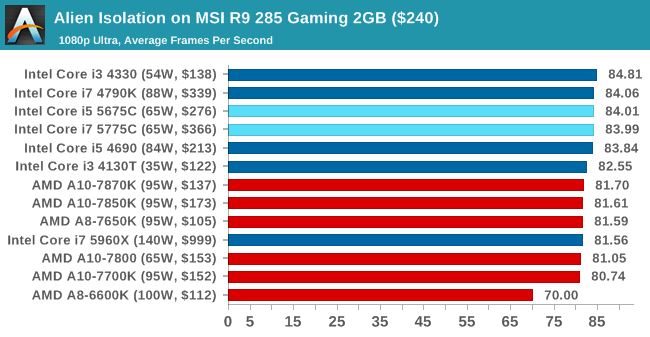
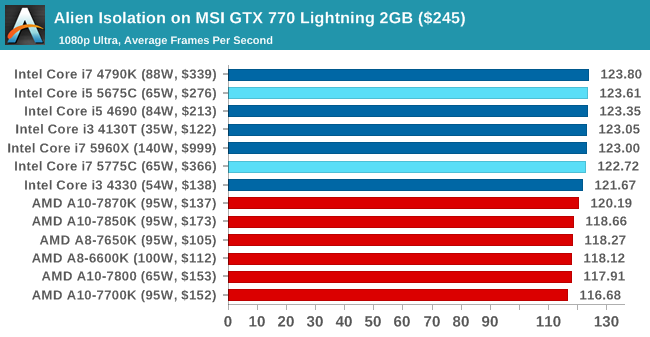
Total War: Attila
The Total War franchise moves on to Attila, another The Creative Assembly development, and is a stand-alone strategy title set in 395AD where the main story line lets the gamer take control of the leader of the Huns in order to conquer parts of the world. Graphically the game can render hundreds/thousands of units on screen at once, all with their individual actions and can put some of the big cards to task.
For low end graphics, we test at 720p with performance settings, recording the average frame rate. With mid and high range graphics, we test at 1080p with the quality setting. In both circumstances, unlimited video memory is enabled and the in-game scripted benchmark is used.
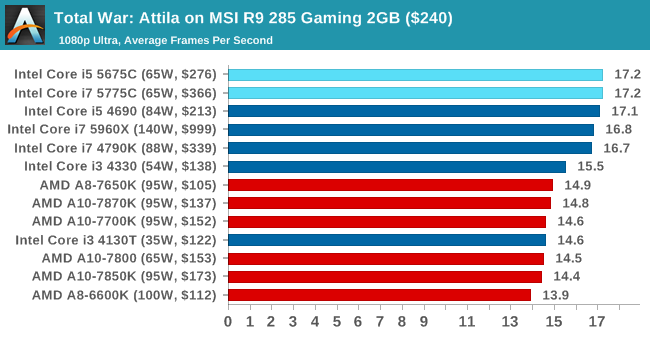
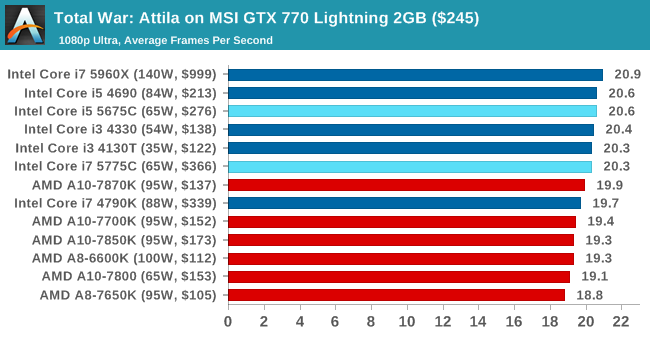
Grand Theft Auto V
The highly anticipated iteration of the Grand Theft Auto franchise finally hit the shelves on April 14th 2015, with both AMD and NVIDIA in tow to help optimize the title. GTA doesn’t provide graphical presets, but opens up the options to users and extends the boundaries by pushing even the hardest systems to the limit using Rockstar’s Advanced Game Engine. Whether the user is flying high in the mountains with long draw distances or dealing with assorted trash in the city, when cranked up to maximum it creates stunning visuals but hard work for both the CPU and the GPU.
For our test we have scripted a version of the in-game benchmark, relying only on the final part which combines a flight scene along with an in-city drive-by followed by a tanker explosion. For low end systems we test at 720p on the lowest settings, whereas mid and high end graphics play at 1080p with very high settings across the board. We record both the average frame rate and the percentage of frames under 60 FPS (16.6ms).
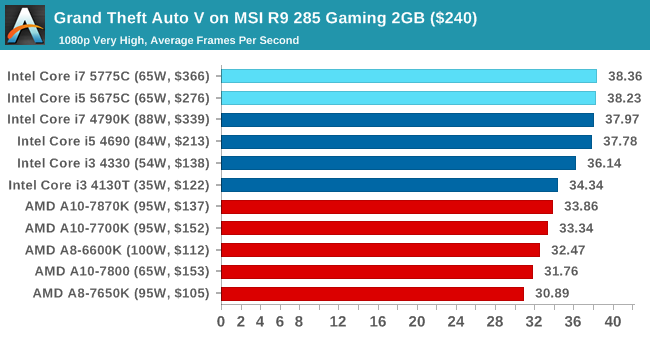
![Grand Theft Auto V on MSI R9 285 Gaming 2GB ($240) [Under 60 FPS]](https://images.anandtech.com/graphs/graph9320/74957.png)
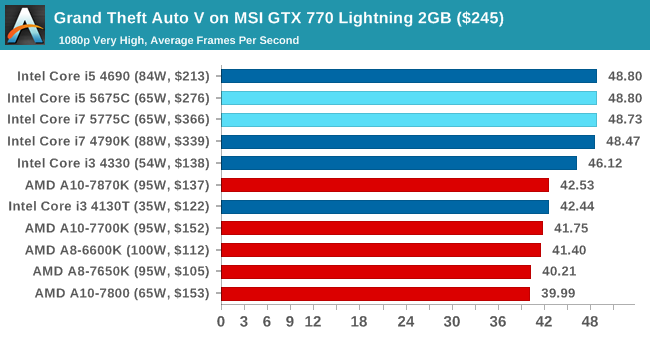
![Grand Theft Auto V on MSI GTX 770 Lightning 2GB ($245) [Under 60 FPS]](https://images.anandtech.com/graphs/graph9320/74967.png)
GRID: Autosport
No graphics tests are complete without some input from Codemasters and the EGO engine, which means for this round of testing we point towards GRID: Autosport, the next iteration in the GRID and racing genre. As with our previous racing testing, each update to the engine aims to add in effects, reflections, detail and realism, with Codemasters making ‘authenticity’ a main focal point for this version.
GRID’s benchmark mode is very flexible, and as a result we created a test race using a shortened version of the Red Bull Ring with twelve cars doing two laps. The car is focus starts last and is quite fast, but usually finishes second or third. For low end graphics we test at 1080p medium settings, whereas mid and high end graphics get the full 1080p maximum. Both the average and minimum frame rates are recorded.

![GRID: Autosport on MSI R9 285 Gaming 2GB ($240) [Minimum FPS]](https://images.anandtech.com/graphs/graph9320/74959.png)
Middle-Earth: Shadows of Mordor
The final title in our testing is another battle of system performance with the open world action-adventure title, Shadows of Mordor. Produced by Monolith using the LithTech Jupiter EX engine and numerous detail add-ons, SoM goes for detail and complexity to a large extent, despite having to be cut down from the original plans. The main story itself was written by the same writer as Red Dead Redemption, and it received Zero Punctuation’s Game of The Year in 2014.
For testing purposes, SoM gives a dynamic screen resolution setting, allowing us to render at high resolutions that are then scaled down to the monitor. As a result, we get several tests using the in-game benchmark. For low end graphics we examine at 720p with low settings, whereas mid and high end graphics get 1080p Ultra. The top graphics test is also redone at 3840x2160, also with Ultra settings, and we also test two cards at 4K where possible.
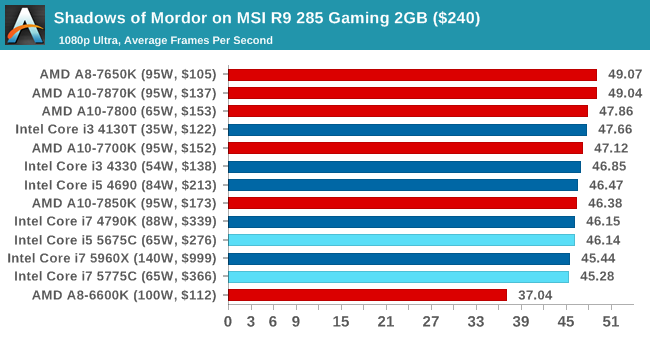
![Shadows of Mordor on MSI R9 285 Gaming 2GB ($240) [Minimum FPS]](https://images.anandtech.com/graphs/graph9320/74961.png)
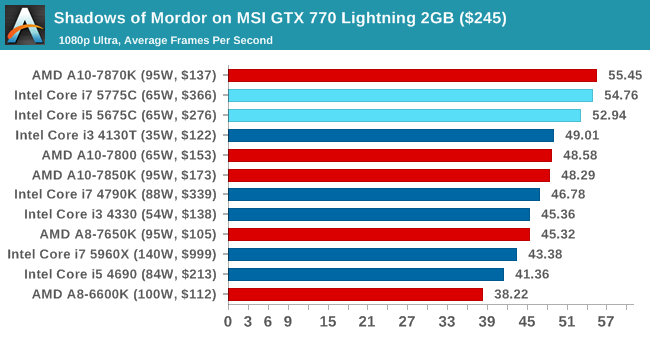
![Shadows of Mordor on MSI GTX 770 Lightning 2GB ($245) [Minimum FPS]](https://images.anandtech.com/graphs/graph9320/74971.png)
Shadows of Mordor at 4K, Single GPU
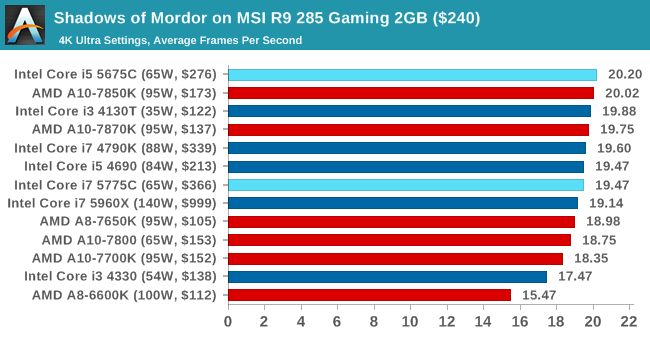
![Shadows of Mordor on MSI R9 285 Gaming 2GB ($240) [Minimum FPS]](https://images.anandtech.com/graphs/graph9320/74963.png)
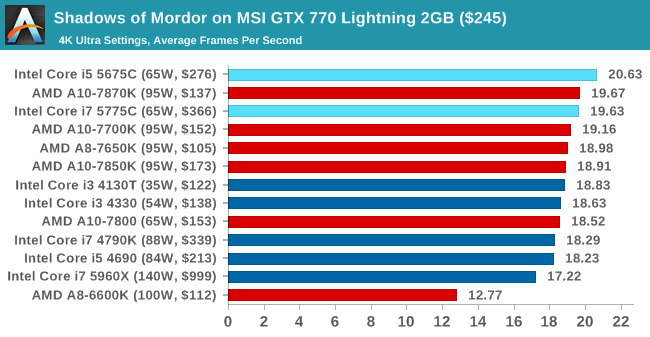
![Shadows of Mordor on MSI GTX 770 Lightning 2GB ($245) [Minimum FPS]](https://images.anandtech.com/graphs/graph9320/74973.png)
Conclusions on Mid-Range Graphics
With the Intel iGPU removed from the picture, what we're seeing here is the combination of Broadwell's architecture improvements, and the Crystal Well eDRAM functioning as an L4 cache for the CPU cores. The biggest benefit here Broadwell-DT was with the R9 285 for GRID on minimum frame rates, showing 75.6 for the 4790K vs 80.06 for the 5775C. Otherwise performance overall is not all that different from what we already see with the best Haswell CPUs, however it's a bit surprising that the Broadwell CPUs don't fall behind, given their rather sizable frequency deficit versus the i7-4790K.















196 Comments
View All Comments
MrSpadge - Tuesday, June 2, 2015 - link
Simply use something representative of the current situation. Not old numbers which may be totally meaningless today. In Europe we have simple price comparison engines like geizhals.eu where it's really easy to find typical prices. Just exclude obvious outliers and cheap products not yet deliverable and voila, you've got the current street price.nathanddrews - Tuesday, June 2, 2015 - link
In Europe? You mean on the Internet? LOLThere are tons of price comparison websites, but why should AT take the time and be responsible for tracking down pricing when we can all do that in our own areas or from our favorite retailers? They don't know where I like to shop or what currency I use, so it seems like a waste of their time. I'd much rather get quality performance analyses on a more regular basis than have them worry about updating price indexes. Who knows? Maybe their new parent company can do that for them off to the side or something?
MrSpadge - Wednesday, June 3, 2015 - link
I never see people from the US referring to them. They seem to just use Newegg or Amazon. And getting prices for European shops won't do AT any good, as they're mainly writing for the US.And AT has to look up the launch prices of the hardware anyway when they write a review. How much more time would it take to instead look up the current price in a comparison engine? Again, I'm not talking about updating prices dynamically.
I they're not doing this you always get comments like "who in their right mind would buy x? Vendor y must be totally stupid to keep offering this". Simply because the launch price is far higher than the current price.
Senpuu - Wednesday, June 3, 2015 - link
Why should AT take the time, you asked? Well, why should they list a price at all then? Hell, why provide any information to the reader beyond specs and performance metrics? Why even talk about the market at all? There is obviously value to be had in doing so and it comes down to where you draw the line. Whereas you would rather they not 'waste their time', I would rather not waste mine by having to question whether a product is being valued near current market price or some esoteric launch price, and then being forced to google multiple things myself to get a feel for 'real world' prices. No, the price they come to will likely not tell me the exact total of the item in question at whatever preferred retailer a reader happens to use, but it will probably be within 5-10% of that value, which is highly useful for at-a-glance comparisons and understanding where something sits in a market segment.We're not talking about a large amount of effort here, but I'd rather AT do it than myself; it's less effort for them and it benefits a large portion of their readers. Simply provide a disclaimer about the methods used to gather the data as well as a liability warning, and everyone's happy.
Thud2 - Saturday, June 13, 2015 - link
Very good point.yannigr2 - Wednesday, June 3, 2015 - link
There are official price cuts and so you have new OFFICIAL pricing that it is fair to put in the charts. If the launch price of 7850K was $500 and the last official price was $100, wouldn't be the above charts completely misleading? People do have a price/performance ratio in their minds when looking at these charts. In fact for 90% that's the biggest parameter when looking at those charts. And those charts LIE exactly there.manifestation88method - Sunday, September 27, 2020 - link
Nice post https://discoversoulpath.com/yannigr2 - Wednesday, June 3, 2015 - link
You can always take the last OFFICIAL price, but nevermind. It's AMD's pricing that it is wrong anyway. Who cares about poor poor AMD?Gothmoth - Tuesday, June 2, 2015 - link
intel is sitting on it´s laurels because there is no competition.AMD is no competition for poweruser.
users want broadwell..mhm.. aha....
i am the only one who wants intel to make a fast 6 (or better 8) core system without integrated graphics, that runs not to hot and does not cost a fortune?
can´t we have such a CPU for 500-600 euro?
ok then i stick to my OC ivy bridge for a few more years.. and you intel can complain about declining sales.
MrSpadge - Tuesday, June 2, 2015 - link
That's exactly what i7-5820K is for. If it consumes too much power for your taste - well, that's simply the price you have to pay for more cores.